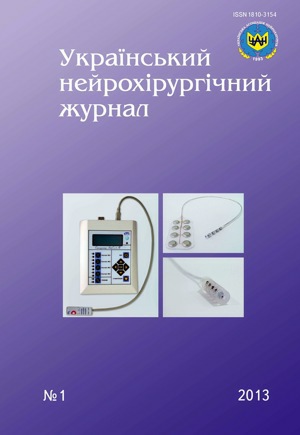Features of endoscope-assisted surgery of adrenocorticotropic hormone-secreting pituitary microadenomas of different topographic types
DOI:
https://doi.org/10.25305/unj.55535Keywords:
pituitary microadenoma, cavernos sinus invasion, endoscopic assistanceAbstract
Introduction. Adrenocorticotropic hormone-secreting (ACTH-secreting) pituitary adenoma is the most frequently diagnosed pathology at the stage of microadenoma. Selective transnasal-transsphenoidal microadenomectomy is the most effective method of treatment.
Materials and methods. We studied 35 cases of ACTH-secreting pituitary microadenomas in post-op period. All 35 patients underwent transnasal-transsphenoidal microsurgical removal of microadenomas, 8 patients underwent endoscopic assisted surgery.
Results. In 75% of patients we found no visible changes of sella turcica, complex anatomy of veins and topography of tumor, pseudocapsule was marginally expressed, we found primary invasion of tumor into diaphragm of sella turcica and cavernous sinus.
Conclusions. In 25% of studied ACTH-secreting pituitary microadenomas cases we found no complex microsurgical anatomy of tumor. Endocsope-assisted surgery facilitates approach to the pituitary fossa, facilitates radical removal of tumor, provides proper level of safety at surgery of pituitary gland.
References
1. Bochicchio D, Losa M, Buchfelder M. Factors influencing the immediate and late outcome of Cushings disease treated by transsphenoidal surgery: a retrospective study by the European Cushings Disease Survey Group. The Journal of Clinical Endocrinology & Metabolism. 1995;80(11):3114-3120. [CrossRef]
2. Kalinin PL, Fomichev DV, Kadashev BA, Trunin IuK, Kapitanov DN, Alekseev SN, Kutin MA, Faĭzullaev RB, Shkarubo AN, Lubnin AIu. [Methods of the endoscopic endonasal transsphenoidal adenomectomy]. Zh Vopr Neirokhir Im N N Burdenko. 2007 Oct-Dec;(4):42-5. Russian. [PubMed]
3. Cappabianca P, Alfieri A, Divitiis E. Endoscopic Endonasal Transsphenoidal Approach to the Sella: Towards Functional Endoscopic Pituitary Surgery (FEPS)*. min - Minimally Invasive Neurosurgery. 1998;41(02):66-73. [CrossRef]
4. Carrau R, Jho H, Ko Y. Transnasal-Transsphenoidal Endoscopic Surgery of the Pituitary Gland. Laryngoscope. 1996;106(7):914-918. [CrossRef]
5. Jho H, Carrau R. Endoscopic endonasal transsphenoidal surgery: experience with 50 patients. Journal of Neurosurgery. 1997;87(1):44-51. [CrossRef]
6. Cappabianca P, Cavallo L, de Divitiis E. Endoscopic Endonasal Transsphenoidal Surgery. Neurosurgery. 2004;55(4):933-941. [CrossRef]
7. Estrada J, Boronat M, Mielgo M et al. The Long-Term Outcome of Pituitary Irradiation after Unsuccessful Transsphenoidal Surgery in Cushings Disease. New England Journal of Medicine. 1997;336(3):172-177. [CrossRef]
8. Ram Z, Nieman L, Cutler G, Chrousos G, Doppman J, Oldfield E. Early repeat surgery for persistent Cushings disease. Journal of Neurosurgery. 1994;80(1):37-45. [CrossRef]
9. Knosp E, Steiner E, Kitz K, Matula C. Pituitary Adenomas with Invasion of the Cavernous Sinus Space. Neurosurgery. 1993;33(4):610-618. [CrossRef]
10. Kalinin PL, Fomichev DV, Kutin MA, Kadashev BA, Astafeva LI, Shkarubo AN, Alekseev SN, Fomochkina LA. [Endoscopic endonasal surgery of pituitary adenomas (experience of 1700 operations)]. Zh Vopr Neirokhir Im N N Burdenko. 2012;76(3):26-33; discussion 33. Russian. [PubMed]
11. Buurman H. Subclinical adenomas in postmortem pituitaries: classification and correlations to clinical data. European Journal of Endocrinology. 2006;154(5):753-758. [CrossRef]
12. Aron D, Howlett T. PITUITARY INCIDENTALOMAS. Endocrinology and Metabolism Clinics of North America. 2000;29(1):205-221. [CrossRef]
13. Mampalam T. Transsphenoidal Microsurgery for Cushing Disease. Annals of Internal Medicine. 1988;109(6):487. [CrossRef]
14. De Divitiis E, Cappabianca P. Endoscopic pituitary surgery : anatomy and surgery of the transsphenoidal approach to the sellar region. Tuttlingen: Endo-Press; 2005.
Downloads
Published
How to Cite
Issue
Section
License
Copyright (c) 2013 Nikolay Guk, Olena Danevych

This work is licensed under a Creative Commons Attribution 4.0 International License.
Ukrainian Neurosurgical Journal abides by the CREATIVE COMMONS copyright rights and permissions for open access journals.
Authors, who are published in this Journal, agree to the following conditions:
1. The authors reserve the right to authorship of the work and pass the first publication right of this work to the Journal under the terms of Creative Commons Attribution License, which allows others to freely distribute the published research with the obligatory reference to the authors of the original work and the first publication of the work in this Journal.
2. The authors have the right to conclude separate supplement agreements that relate to non-exclusive work distribution in the form of which it has been published by the Journal (for example, to upload the work to the online storage of the Journal or publish it as part of a monograph), provided that the reference to the first publication of the work in this Journal is included.









